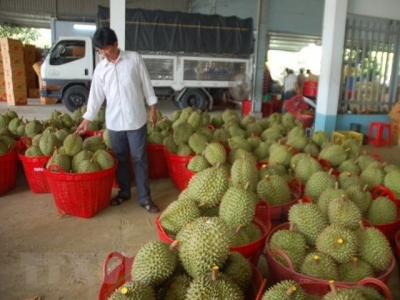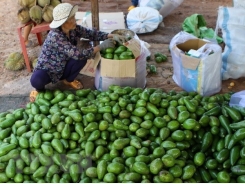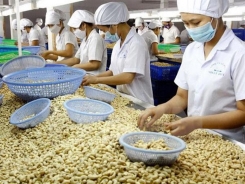Durian shortage torments Bến Tre

Rising demand for durian from the Mekong Delta and an increasing preference among farmers to grow the fruit off-season to benefit from higher prices have caused prices in Bến Tre Province to rise sharply, even though the main harvest season is underway. —VNA/VNS Photo Minh Trí
BẾN TRE — Though the durian harvest season is in full swing in the Mekong (Cửu Long) Delta Province of Bến Tre, the price of the fruit remains high since many farmers have switched to growing the fruit in the off-season and consumers have rediscovered a taste for Vietnamese durian.
Nguyễn Văn Tùng who owns one hectare of durian in Hưng Khánh Trung B Commune of Chợ Lách District said buyers have been coming to his farm almost everyday since last week asking to buy his durian.
Farmers are selling Ri6 durian on the farm for VNĐ50,000-VNĐ53,000 (US$2.2-2.3) per kilogramme.
Tùng said: “I am quite surprised. This is the first time my durians are fetching such a high price.
“Usually a kilogramme would hardly fetch VNĐ40,000.”
According to local durian growers, the price of the “king of fruits” has been going up since the start of the harvest season (mid-May), and they expect it to reach the price of off-season durian they harvested during Tết (the Lunar New Year) last February.
Usually during the main season prices are around VNĐ10,000 lower than during the off-season, but the cost of growing during the season is also lower.
Ngô Tường Vy, deputy director of fruit import-export company Chánh Thu, said another reason for the high prices now is that Vietnamese consumers prefer durian from the delta to imports from Thailand.
The decline in the area on which durian is grown during the regular season has led to a fall in supply, she said.
Bến Tre now has around 3,500ha under the fruit, with an average yield of 15-20 tonnes per hectare per year.
Last November in Chợ Lách and Châu Thành districts, the main growing areas, farmers switched to growing off season on around 700ha, or 40 per cent of the total growing area.
They harvested the fruit around February.
Có thể bạn quan tâm
Phần mềm

Phối trộn thức ăn chăn nuôi

Pha dung dịch thủy canh

Định mức cho tôm ăn

Phối trộn phân bón NPK

Xác định tỷ lệ tôm sống

Chuyển đổi đơn vị phân bón

Xác định công suất sục khí

Chuyển đổi đơn vị tôm

Tính diện tích nhà kính

Tính thể tích ao hồ



 Central provinces to use more high-tech agriculture
Central provinces to use more high-tech agriculture  Increasing processed lychee volume, reducing consumption pressure
Increasing processed lychee volume, reducing consumption pressure